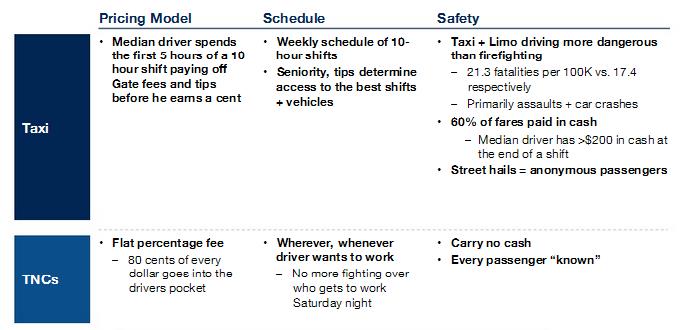October 24, 2014
The taxi industry and its start-up offshoots, such as Uber and Lyft, have been dominating the news lately; a simple Google search for Uber news, for example, produces 10.7 million results. SherpaVentures, a venture-capital firm that has invested in a number of start-ups, and whose founder was a large investor in Uber, recently released a report of what it refers to as the “on-demand economy,” which they describe as based on the “instant, pervasive access to goods and services, tailored to individual needs, often without the burden of long-term ownership or commitment.” SherpaVentures, however, paints a positive, but incomplete, picture of what these new forms of economic organization mean, especially for the workers involved. While there is a lot not to like about the report, I will limit myself here to their comparison of traditional taxi drivers and Uber drivers.
SherpaVentures assembled a chart (see below) outlining ways in which “transportation network companies” (TNCs) like Uber are an attractive alternative to traditional taxi companies for drivers. Traditional taxi companies’ pricing models definitely leave a lot to be desired. Taxi drivers do often start out the workday in debt, but “TNC” drivers don’t really earn the flat 80 percent fee described by SherpaVentures. The given estimates of driver earnings are not as high as claimed because SherpaVentures has conveniently excluded the cost of fuel, insurance, vehicle maintenance, and financing from their figures.
Things are likely to get worse. SherpaVentures predicts that “UberX fares will continue falling and could easily reach 70 percent below the cost of a taxi.” The fixed costs to drivers, however, will not decrease correspondingly. Since TNCs like Uber will still expect their cut, the cost reductions will most likely come out of drivers’ earnings. And, as Catherine Rampell explained in a recent Washington Post piece, both drivers and consumers may lose out in the long-run once one company dominates market share, where it will be well-positioned to raise prices for consumers and cut wages for workers. This is already happening in parts of the country, with new UberX drivers in San Francisco paying a 25 percent fee to the company, a change contrary to SherpaVentures’ idea of “flat percentage fees” in the range of five to 20 percent.

Furthermore, the flexible scheduling in TNCs is not that different from many traditional taxi companies. (Disclosure and personal plug: As a student, I completed a research project on taxi drivers in northern Virginia. If you would like to read more and listen to some of my interviews, see the link here. A consistent theme in these traditional taxi drivers’ stories was the independence and flexible scheduling afforded to them.) Both groups of drivers may find themselves working long hours to cover their costs and make a minimal income. Of course, as independent contractors, neither drivers for traditional taxi companies or Uber are entitled to the guarantees of a minimum wage or overtime pay.
TNC drivers also face many of the same safety concerns as regular drivers. They are still subject to the risk of assault and accidents. They may not carry as much cash as traditional taxi drives, but they have at least one smart phone and often another phone or GPS device; and they have been assaulted in anonymous ambushes by those who, as one author suspects, may have used the app’s GPS to locate potential victims.
Overall, any benefits to driving for Uber as opposed to traditional taxi companies are quickly diminishing, and the case for TNCs offered by SherpaVentures is incomplete and often misleading. The vision of the on-demand economy is more tailored to company profits than individual needs, with no commitment to either customers or workers.






